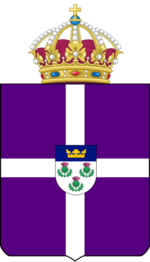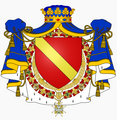Monarchy of Caldia: Difference between revisions
m (1 revision imported) |
mNo edit summary |
||
| (6 intermediate revisions by 2 users not shown) | |||
| Line 1: | Line 1: | ||
{{wip}} | |||
{{Infobox monarchy | {{Infobox monarchy | ||
| royal_title = King | | royal_title = King | ||
| realm = | | realm = Caldia | ||
| coatofarms = Glytter_Greater_CoA.png | | coatofarms = Glytter_Greater_CoA.png | ||
| coatofarms_article = Coat of arms of | | coatofarms_article = Coat of arms of Caldia | ||
| image = KennethIV.jpeg | | image = KennethIV.jpeg | ||
| incumbent = [[Kenneth IV]] | | incumbent = [[Kenneth IV]] | ||
| Line 18: | Line 19: | ||
{{Politics of Glytter}} | {{Politics of Glytter}} | ||
The '''monarchy of the | The '''monarchy of the Caldia''', commonly referred to as the '''Caldish monarchy''', is the {{wp|constitutional monarchy}} of [[Caldia]]. The {{wp|monarch}}'s title is usually tied to their gender, with females taking "Queen" while males take "King". The current monarch, [[Kenneth IV|King Kenneth IV]], ascended the throne following the abdication of King Elton II on 5 August 2010. | ||
The monarch and his or her immediate family undertake various official, ceremonial, diplomatic and representational duties. As the monarchy is constitutional, the monarch is limited to non-partisan functions such as bestowing honours and appointing the [[Taoiseach of | The monarch and his or her immediate [[Caldish Royal Family|family]] undertake various official, ceremonial, diplomatic and representational duties. As the monarchy is constitutional, the monarch is limited to non-partisan functions such as bestowing honours and appointing the [[Taoiseach of Caldia|Taoiseach]]. The monarch is, by tradition, commander-in-chief of the Caldish Armed Forces. Though in the past the ultimate formal executive authority over the government of Caldia was by and through the monarch's {{wp|royal prerogative}}, these powers have been gradually dissolved through various laws and acts, all of which found support from the reigning monarchs. | ||
The | The Caldish monarchy traces its origins from the Warring Clans period, during which High Chieftess Daireann of Aerach married High Chief Torán of Diabhal. Following their union of both house and nation, she launched a successful campaign to unify the island, and as a result established the [[Kingdom of the Ghailles]], with herself as Queen of the Ghailles. The current title stems from Queen Ailbe II, who renamed her kingdom after the [[Caldish Isles]] on 20 May 1017. | ||
| Line 57: | Line 58: | ||
File:Glytter Greater CoA.png|The arms of the House of MacIconnich, first used under [[Alastar of | File:Glytter Greater CoA.png|The arms of the House of MacIconnich, first used under [[Alastar of Caldia|Alastar the Great]], are the arms of the state and the monarchy as an institution. | ||
File:House of MacI-Xan Arms.png|The arms of the [[House of MacIconnich- | File:House of MacI-Xan Arms.png|The arms of the [[House of MacIconnich-Sartoux]] are the personal arms of the monarch. | ||
</gallery> | </gallery> | ||
==Residences== | ==Residences== | ||
[[Category: | [[Category:Caldish monarchy]] | ||
[[Category: | [[Category:Politics of Caldia]] | ||
[[Category: | [[Category:Government of Caldia]] | ||
Latest revision as of 09:37, 26 July 2020
This article is incomplete because it is pending further input from participants, or it is a work-in-progress by one author. Please comment on this article's talk page to share your input, comments and questions. Note: To contribute to this article, you may need to seek help from the author(s) of this page. |
| King of Caldia | |
|---|---|
 | |
| Incumbent | |
 | |
| Kenneth IV since 5 August 2010 | |
| Details | |
| Style | His Majesty |
| First monarch | Daireann I |
| Formation | 720 CE |
| Residence | St Ellen's Palace |
| Website | royal.gov.gl |
 |
|---|
| This article is part of a series on the politics and government of Caldia |
|
|
The monarchy of the Caldia, commonly referred to as the Caldish monarchy, is the constitutional monarchy of Caldia. The monarch's title is usually tied to their gender, with females taking "Queen" while males take "King". The current monarch, King Kenneth IV, ascended the throne following the abdication of King Elton II on 5 August 2010.
The monarch and his or her immediate family undertake various official, ceremonial, diplomatic and representational duties. As the monarchy is constitutional, the monarch is limited to non-partisan functions such as bestowing honours and appointing the Taoiseach. The monarch is, by tradition, commander-in-chief of the Caldish Armed Forces. Though in the past the ultimate formal executive authority over the government of Caldia was by and through the monarch's royal prerogative, these powers have been gradually dissolved through various laws and acts, all of which found support from the reigning monarchs.
The Caldish monarchy traces its origins from the Warring Clans period, during which High Chieftess Daireann of Aerach married High Chief Torán of Diabhal. Following their union of both house and nation, she launched a successful campaign to unify the island, and as a result established the Kingdom of the Ghailles, with herself as Queen of the Ghailles. The current title stems from Queen Ailbe II, who renamed her kingdom after the Caldish Isles on 20 May 1017.
History
Foundation
Modern Status
Constitutional role
Appointment of the Taoiseach
Dissolution of the Comhthionól Náisiúnta
Royal Prerogative
Religious role
Voting rights
Succession
Restrictions by religion
Regency
Style
Arms
- GlytterOldArms.png
The arms of the House of Mac Aillán.
The arms of the first MacIconnich monarchs from 1082-1219.
- ArmsofMorcanIX.png
The arms of Morcan IX, used from 1395 to 1397.
From 1626 to 1630 the arms of the Dejarlis family served as the personal and state arms for John I.
The arms of the House of MacIconnich, first used under Alastar the Great, are the arms of the state and the monarchy as an institution.
The arms of the House of MacIconnich-Sartoux are the personal arms of the monarch.


